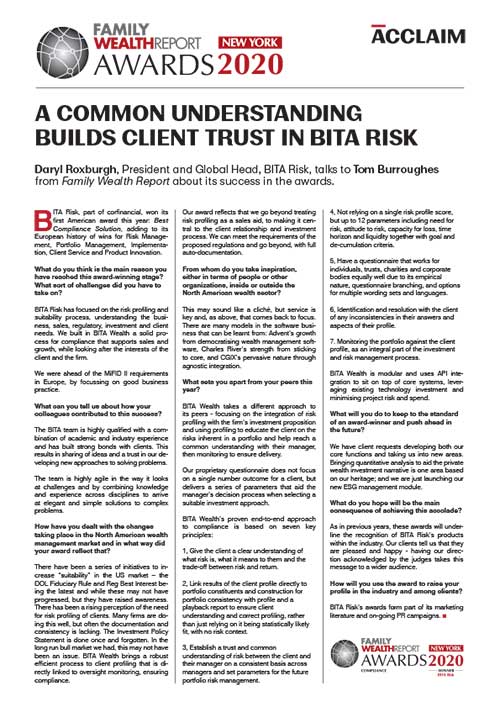Daryl Roxburgh, President and Global Head of BITA Risk® part of the corfinancial® Group

In a discussion last week with a CIO, he said, “investors may be disappointed in returns – due to the market – but they do not want to be surprised”. This prompted us to write about how to avoid surprises, or “the intelligent anticipation of the unexpected”.
Identifying, understanding and mitigating portfolio risks will help remove surprises and lead to more consistent portfolio performance. This does not have to mean 100% rebalancing to a strict model, something that is not always appropriate or possible in HNW and UHNW client portfolios. More than with the right oversight and insight, managers can have freedom within a framework to deliver good suitable outcomes to their clients.
Automating the analysis of portfolios and assets to identify those that fall outside client mandate or investment policy does six things:
- Focus attention where needed
- Prioritises action by criticality
- Identifies patterns or systematic behaviour
- Enables known issues to be validated with the client and removed from the exceptions list
- Reduces data prep time by 80%, effort that can be better focussed on actions
- Puts the tool on the IM desk, making it part of daily portfolio management
Checking beyond basic front office system drift and client restrictions, we would suggest considering eleven different groups of monitor tests, to find the proverbial needle in the haystack before it becomes a risk:
- Portfolio market risks
- Concentration risks
- Bond metrics
- Performance deviation
- Goal achievement deviation
- ESG and ER and preferences and restrictions
- Asset allocation
- Asset class characteristics
- Research and non-research list assets positions
- Asset attribute flags e.g., risk, liquidity, rare, restricted
- Admin flags e.g., review due, dummy identifiers
The appropriate and relevant tests will depend on the firm’s investment proposition and business model. Often, different business units served by the same installation will only have a few tests in common.
You might know that 80% of your portfolios have a minimum of 80% invested in assets on the research list, but how concentrated is the money not invested in the research list? Are there significant positions either at the firm or branch level that are not researched, and are these a risk?
Do certain teams or branches have systematic outlier characteristics? Do certain managers have a very high proportion of portfolios with a CGT exception?
Monitoring these daily not only gives the IM the heads up that they need to check something when it occurs but also provides a trend report through time on the resolution of issues, so continual analysis helps stay on top.
Just as important is a structured process of recording accepted and known exceptions. These not only need internal checks but should also be validated with the client on a periodic basis, closing the loop.
The result of the use of this data, analysis, and process can be expected to be:
- Better delivery to client expectations and suitability of outcome
- Reduction in unexpected risks
- Improved consistency of outcome
- Demonstrable automated risk management process to attract clients, advisers and IMs
- Better understanding of the relationship between risks and return in the business.
The frequent comment about Consumer Duty is that much of it is just good business practice. The management information listed above can evidence good outcomes and that the processes are in place to ensure they are being beneficial to the client and firm alike.
If you would like to discuss any of the points raised here, please contact us at BITARisk@corfinancialgroup.com or see more information on our solution here.














